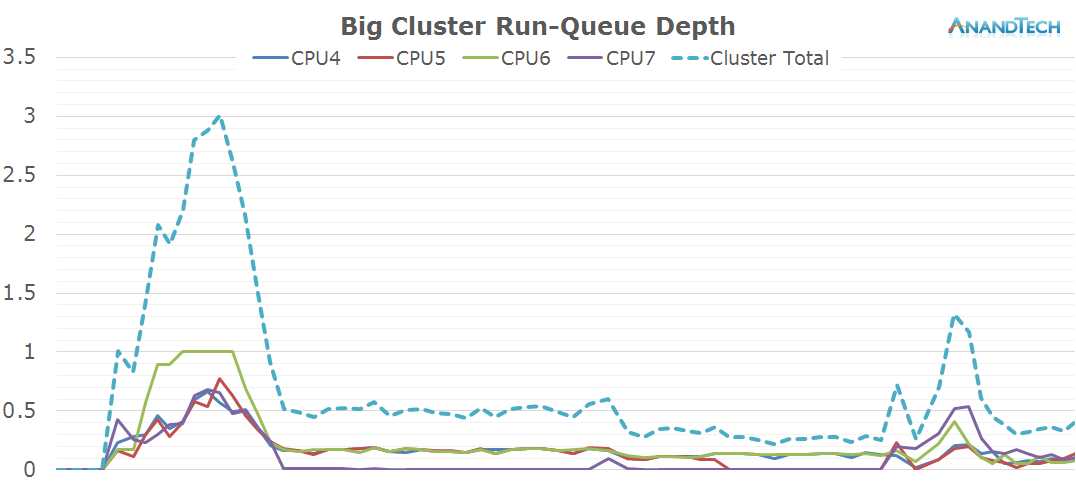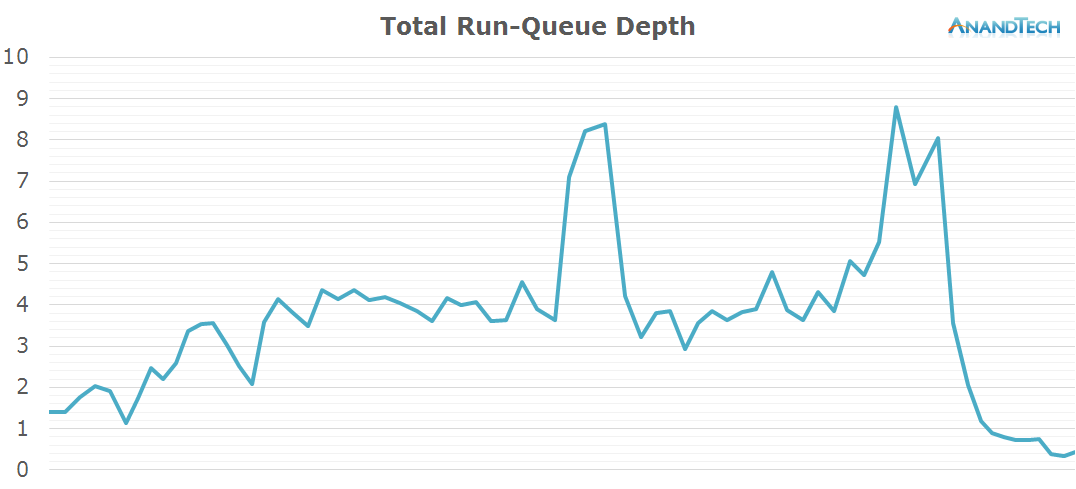The Mobile CPU Core-Count Debate: Analyzing The Real World
by Andrei Frumusanu on September 1, 2015 8:00 AM EST- Posted in
- Smartphones
- CPUs
- Mobile
- SoCs
Camera Video Recording
Video recording absolutely makes use of all little cores at once. As we see in the power state distribution chart all cores are predominantly in their active clocked states doing some work. The scheduler run-queue depth also points out that this is a case of at least 4 larger threads that reside on the small cluster.
During the actual video recording the big cluster runs at only 800MHz. Nevertheless, it still sees some activity as 3 cores have some small threads placed on them.
All in all it looks like video recording is about a large number of small threads. There are two spikes in the total run-queue depth that were predominantly caused by the little CPU cluster which pushed the total rq-depth up to 8 in for short moments. I'm not sure what caused the spikes as I remained relatively still during the recording and did no special activity to warrant such behaviour.

















157 Comments
View All Comments
lilmoe - Tuesday, September 1, 2015 - link
"if the interest is high enough":/ Really?
zaza - Saturday, September 5, 2015 - link
Yes Please. It would be nice to see if the same or similar tests works on snaprdagon 810,801 and 615 and Mediatek chips, and intel SoCerchni - Thursday, September 17, 2015 - link
A follow-up with synthetic would be quite interesting.aryonoco - Saturday, September 5, 2015 - link
I just wanted to reiterate the point here an thank the author for this great piece of technical investigative journalism.Andrei, thank you for this work. It is hugely invaluable and insightful.
tipoo - Tuesday, September 1, 2015 - link
Very interesting article. Seems like the mantra of "more cores on mobile are just marketing" was wrong in terms of Android, seems to dip into both four core big and little clusters pretty well. That puts the single thread performance having lagged behind the Apple A series (up until the S6 at least) in a new light, since it can in fact use the full multicore performance.tipoo - Tuesday, September 1, 2015 - link
*That is, barring gaming. More core Android functions do well with multithreading though.jjj - Tuesday, September 1, 2015 - link
In gaming there is a big advantage. By using mostly the small cores you allow for more TDP to go to the GPU. One more relevant thing would console ports in the next couple of years when mobile GPUs will catch up with consoles. The current consoles have 8 small cores and that fits just right with many small cores in Android.retrospooty - Tuesday, September 1, 2015 - link
Not really sure whos "mantra" that was. People that don't understand what the big.little architecture is like some angry Apple fans?tipoo - Tuesday, September 1, 2015 - link
Well sure, whoever they were, but it was a pretty common refrain for every 8 core SoC.soccerballtux - Tuesday, September 1, 2015 - link
for one, it was my mantra. I liked having 4 cores because 2 wasn't enough, but according to my hotplugging times, I only really need 3 for optimal experience most of the time